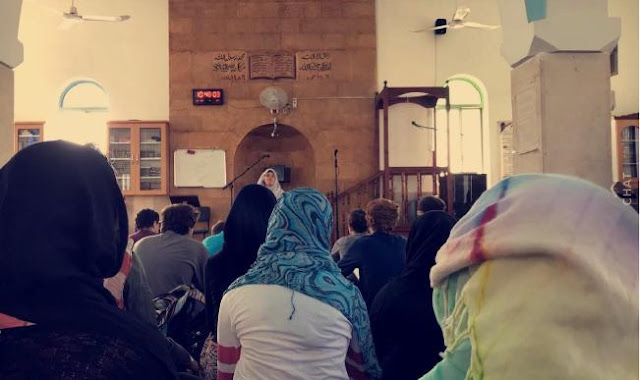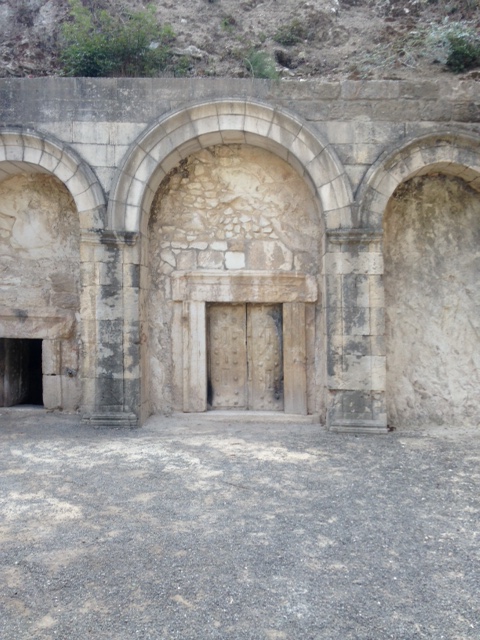Yam L’Yam (sea to sea)
by Jacob Gencher, grade
11, Ontario
 |
| Heller High students hiking up Mount Meiron during the Yam L'Yam hike |
A nice, relaxing, stress-free Sukkot with a kind and accepting
host families abruptly halts and we are plunged into a harsh, tiring and
rigorous reality that is the Yam L’Yam trip. Yam L’Yam is a 5 day trip that
enriches the students’ perception of the land of Israel and the significance of
it, with an experience that will never be forgotten.
Starting at the Sea of Galilee, we embarked on our hike in a very enjoyable and
unique way. A short hike through a beautiful stream, shrouded in greenery that
formed a canopy protecting us from the glaring sun, was one of the most loved
parts of the entire trip. This water adventure was filled with laughter, joy
and smiles stretching from ear to ear. To mark the beginning of our adventure,
we filled a bottle with water from the stream to be couriered to the
Mediterranean Sea. After our time at the stream, we boarded the bus and headed
to our first campsite. After a little bit of relaxing and arranging our tents,
dinner was ready for us. After dinner, we played games, bonded and marveled at
the beauty of the starry sky.

The second day was full of excitement. After waking up fearing the worst, as my
backpack was missing, I was relieved and quite happy to find m y backpack was
not stolen, but rather dragged by wolves up a cliff behind my tent. The day
started out with a “Broga” Tefilla, hosted by Dani and Michael. It was an
excellent way of incorporating the goal of Yam L’Yam, connecting to the land of
Israel, with prayer. We started our hike at an old police station that was used
while the British had control over Israel, which I thought was very
interesting. Having been a Shabbat, this hike was not very long and was only to
get a feel for the type of landscape we would trek in the upcoming days and get
a little taste of the spectacular views we would experience. We returned after
the hike and were divided into three groups. Each group would be responsible
for cooking their own breakfasts and lunches. After being divided, we entered a
competition; utilizing the skills of fire building we had just been
taught. The most important part of the day was celebrating two students’
birthdays, Noya and Lillian, by a camp fire. We played games, danced and had a
great time.
 |
| It's all sunny in this photo, but the rain came later! |
The third day was the most exhausting of the trip. We started the day returning
to the old police station and beginning another hike. After about an hour of
hiking we stopped, split into our groups and made our breakfast. It wasn’t the
most exquisite meal, but the porridge, tea and biscuits were bland, but not the
worst. After breakfast we packed up and headed toward our main objective, Mt. Meiron.
The hike was extremely interesting. We walked through a very out of place
tunnel, witnessed extremely beautiful views and did some serious rock climbing.
After climbing up a very steep incline covered in rocks and scaling rock walls
for a couple hours, we stopped for lunch. Lunch was much more flavourful than
breakfast; rice, sandwiches and salami really made for a delicious meal. After
lunch we were taught a bit about navigation and how to use a map. We then
headed into a small village. While in the village, it started to drizzle, which
was not particularly bad and it helped spice things up. After exiting the
village, we walked for what seemed like an eternity until finally, we reached
the peak of Mt. Meiron. The view was spectacular! Looking out over the horizon
made me feel like I could accomplish anything. What made the view truly amazing
is that we were shown our starting point and the old police station in the
distance.
 |
| The remains of an old British police station was on our trail during the hike. |
Climbing Mt. Meiron I feel is a metaphor for life, in that, the path
to your objective may be full of obstacles, and things will weigh you down (in
this case it was a backpack with four liters of water, a bowl, spoon, cup,
cooking materials and leftover food), but if you persevere and reach your goal,
when you look back, you will feel accomplished and realize that the journey was
worth it. After a short talk about Mt. Meiron and the significance of it, we
unfortunately had to take a break from hiking and took a bus back to our
original campsite, instead of hiking to the next one, because of weather
issues. We arrived at the campsite, set up tents, ate dinner and had an
activity that revolved around loneliness and silence. It was a break from the
daily schedule and was a time of reflection. After sitting alone on a trail for
about twenty minutes, we sat in a circle and talked about fears and anxiety. It
was a very nice activity that helped me connect more to Israel and to myself.
The fourth day was a bit of a disaster at the beginning, but turned around
later in the day. I woke up full of excitement and ready to start a new day,
but my excitement quickly diminished as it started to rain. Panic spread
throughout the campsite. People ran to get raincoats, to put their suitcases in
the tent or under a tarp and the group’s morale instantly dropped. The rain
started to pick up more and more and it seemed like we were doomed, until our
hero, Yonatan, grabbed his speaker, turned on some Israeli music and started
dancing in the rain. Others soon joined him and this disastrous rain turned
into a fun activity. After the rain had died down, we headed onto another bus a
returned to the base of Mt. Meiron. We were divided into our groups and given
maps for the activity that was planned. This activity was denied by another
wave of rain. We all huddled under a canopy made of one very large stone,
soaking and shivering, and waited for the rain to pass. In this state of
despair came one of the best moments of the entire trip. We all gathered in a
circle and started to sing the Wii theme song. Childish, sure, but it was
surprisingly amusing and boosted the spirits of the group. The rain was
relentless and eventually a bus was called to pick us up. While waiting for the
bus we played freeze tag, which was a lot of fun and made me forget all about
the rain ruining the day. The bus finally arrived and we boarded it. The bus
took us to our next hiking location. Before beginning the hike we had lunch and
had a cooking competition. After we had finished lunch with revived spirits, we
revisited our night program and walked alone. I was skeptical at first, but I
am glad I walked alone, for it helped me appreciate the view of the mountains
and gave me another chance to exclude myself from the group I have become so
attached to. After we met up and walked a little bit more as a group, we
arrived at our new campsite. We set up our tents, ate dinner, had a small
campfire and went to sleep.
The fifth day was, in my opinion, the best of the trip. We woke up, packed all
of our things, returned our cooking supplies and sleeping bags and prepared for
the bike ride. A truck hauling thirty or forty bikes arrived at our campsite.
After a brief talk about safety and rules, we were each given a bike and just
like that, we were off. Taking it slow, we descended our first hill. It was
amazing. The wind blowing in your face, the pleasant aroma surrounding you and
feeling like you’re flying. The bike ride was the most enjoyable activity I
have participated in on the entire trip of NFTY Heller High. It was
unbelievably fun. Riding on trails, roads, through villages and through a
banana plantation made the bike ride’s scenery more interesting than the past
four days’. After biking for multiple hours, we finally arrived at our
destination: the Mediterranean Sea. Everyone wasted no time heading into the
beautiful complex that overlooked the Sea. Relieved that we had finished, we
sat in a circle and talked about our favourite part and the most difficult part
of the trip. It was very interesting, seeing everyone’s enjoyment come from
different places of the trip, but what was more interesting was that some
people, myself included, had trouble finding something they didn’t like about
the trip. After, we looked at a map and traced our path. It was truly
remarkable to think that we walked all of that distance, and with relative
ease. When the talk was over, we all rushed to the washroom to get changed and
headed down to the beach to swim. We all headed down to the beach and, before
swimming, dumped the water from the Galilee into the Sea. We then ran into the
Sea with joy. After a couple hours of swimming we were pulled out and ate
lunch. After lunch we went back to the Sea for a few more hours and we all had
a great time. After five days of mud, dirt and sweat, a nice swim was exactly
what we needed.

Yam L’Yam is a trip that I will never forget, and for good reasons. After
experiencing the trails, the views, the good (and the bad) weather, and an
overall sense of belonging makes it easy to understand why it would be the
national pastime. It gives you a better appreciation of the country you are
living in or visiting. On a program like NFTY Heller High, where the main goal
is to give the students a better perception of Eretz Yisrael, a trip like Yam
L’Yam is the best way of presenting and enforcing the importance of the
country. Jewish History class sometimes makes me wonder about the relevance of
what we learn, but this trip has helped me realize, by a first-hand experience,
that everything that happened in the history of the Jews had always revolved
around the country of Israel, and now I understand how important that is.


























